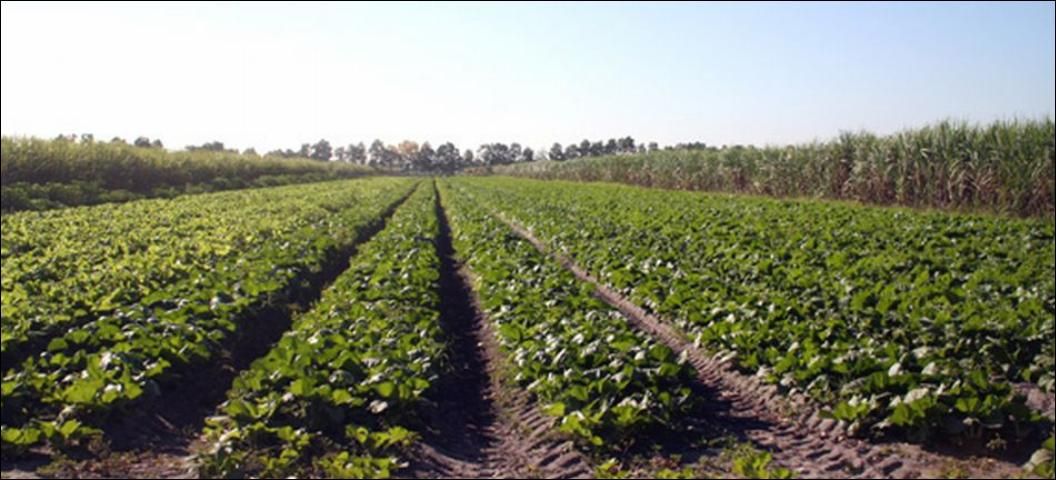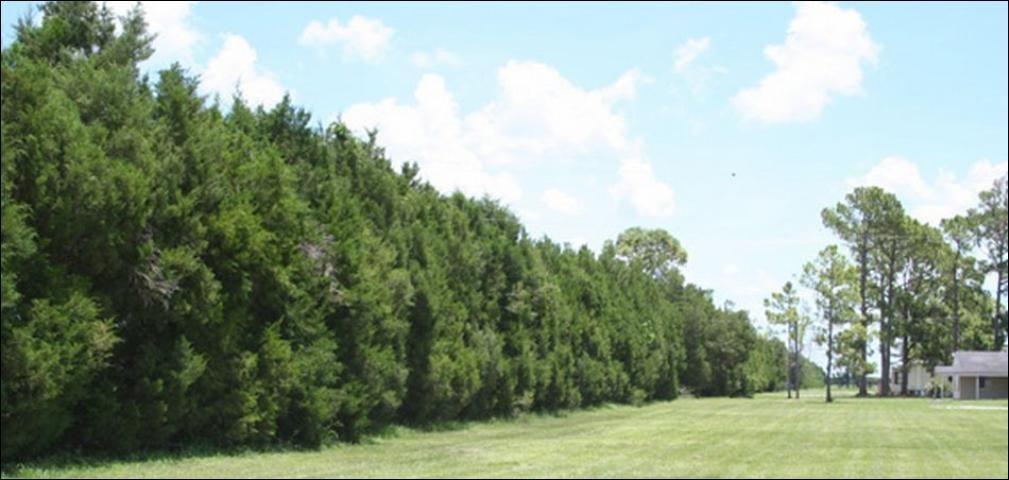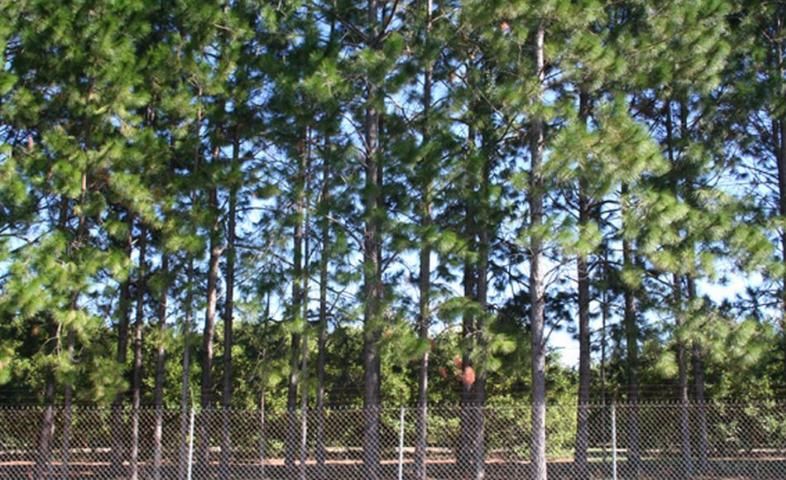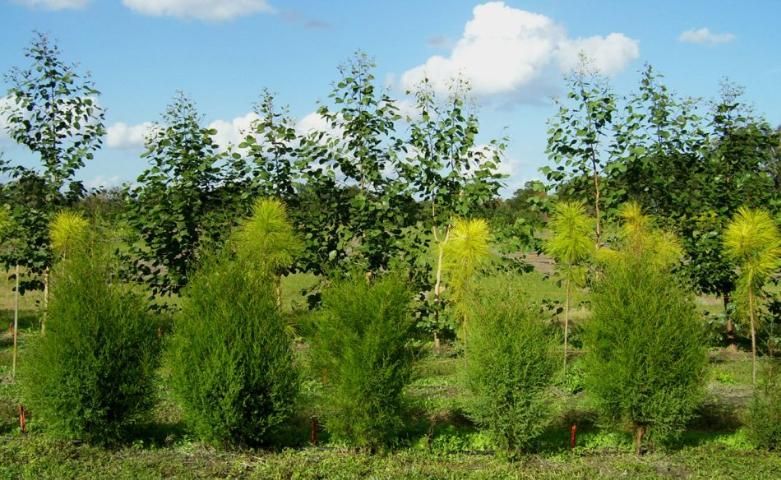For decades, researchers, farmers and institutions have recognized the advantages of windbreaks in agricultural systems worldwide. Windbreaks have proved to be beneficial for sustainable agriculture by improving crop production and enhancing conservation activities (Guthrie 1942, Nuberg 1998). For example, a well-designed windbreak located in the direction of a prevailing wind can increase crop yield, reduce soil erosion, influence microclimate around the crops, increase irrigation efficiency, and control the spread of some pathogens. Studies have shown that the effective distance of wind reduction on the lee side (protected side) of a windbreak ranges between 10 to 30 times the height of the windbreak (Wang and Takle 1995, Cleugh 1998). Before planting a windbreak, then, it is important to understand the species of the plant used and the amount of space available.
There are two types of windbreaks, living (natural) and non-living (artificial). Each type serves to reduce wind, but there are economic tradeoffs associated with each. This paper will focus on the advantages and disadvantages of living windbreaks.
Living windbreaks are mostly composed of trees and shrubs, and in some cases tall grasses (Figure 1 and Figure 2). Artificial windbreaks are vertical structures made from a variety of materials including metal and plastic cloth. One of the primary economic advantages of a living windbreak is that it is a cheap and cost-effective technology due to low establishment and maintenance costs. The primary economic disadvantage is that a living windbreak may take several years to develop; therefore, the economic benefit is not immediate.

Credit: Bijay Tamang, December 21, 2007

Credit: Bijay Tamang, July 11, 2007
Vegetables and citrus are the major farm products of Florida. Both operations are profitable and the products are exported to other US states and countries (about 140 countries in 2006). However, the citrus industry is gradually declining due to adverse conditions and diseases. For these growers, windbreaks have the greatest potential to improve crop quality and yield. Some of the benefits growers may obtain by the use of windbreaks are discussed in the following sections.
Reduction of Soil Loss
Soil erosion is the primary concern where fields are subjected to regular high winds. Windbreaks can reduce soil erosion by ameliorating wind speed across open fields. The susceptibility of soil to erosion is a function of particle size; clay and silt particles are easily removed from the surface at low wind speeds while sand particles need relatively high wind speeds. It can be expected that windbreaks will reduce erosion on the lee side of trees in the protected zone.
Reduction of Nutrient Loss
Nutrient loss from wind-eroded soil can be a major problem in areas where nutrients are concentrated in the top layer of soil. Studies show that wind-transported soil contains a significant amount of nutrients and, in most cases, has a higher nutrient level than the remaining topsoil in the field (Leys and McTainsh 1994, Larney et al. 1998, Nuberg 1998, Sudmeyer and Scott 2002a). It has been suggested that wind erosion causes a significant amount of soil loss in Florida (Gillette 1986, DeWiest and Livingston 2002). This can be a critical problem in areas where fields are regularly fertilized and left fallow after harvest. Windbreaks reduce wind speeds so both soil erosion and nutrient loss can be reduced, providing growers with economic savings.
Reduction of Evapotranspiration
Moisture stress, caused by a combination of wind, high temperatures and low humidity, is immediately apparent in many crops such as vegetables and other shallow-rooted herbaceous crops. Moisture stress leads to wilting, stomata closure, and cessation of photosynthetic activity, which ultimately leads to plant death. Fruit set on vegetable crops can be seriously reduced if water becomes limited. Because windbreaks control wind speed behind the barrier, they reduce evaporation from bare soil and transpiration from crops (Cleugh 2002), thus making plants behind the windbreak less likely to suffer from moisture stress and reducing the irrigation requirements.
Reduction of Irrigation Loss
As concerns about water consumption and prices increase, it is important to irrigate fields efficiently. Windbreaks increase the efficiency of overhead irrigation by reducing wind speed and keeping sprayed water only on the targeted areas.
Reduction of Physical Abrasion to Crops
Wind-transported soil particles also contaminate vegetables and small fruits (such as strawberries) and often reduce their quality. Frictional marks from high-speed wind reduce the quality of leafy vegetables, fruits, flower crops, bedding plants, and other high value crops. This is also a concern during flowering and fruit onset of produce. Windbreaks can alleviate some of these problems.
Reduction of Agricultural Chemical Drift
Chemicals, including insecticides, fungicides, herbicides, etc. are regularly applied in aqueous sprays to agricultural fields. During their application, small droplets remain suspended in air and are easily carried to non-targeted areas by the wind (drifts). Such drifts are lost for their control purposes and represent money wasted; additionally, drifts can cause health and environmental hazards to people, wildlife, and habitat and can be a legal liability. Windbreaks act as buffers in such areas to control both the above-ground movement of pesticide drifts and their underground movement into wetlands and water sources.
Reduction of Disease
Citrus is one of the major agricultural products in Florida and its yield has been severely impacted by citrus canker (Xanthomonas campestris pv. citri). Citrus canker is caused by bacteria, which are vectored by wind and rain. Citrus canker dispersal has been documented locally (between trees in a grove or nursery) and long distances (between groves) due to blowing rainstorms (Gottwald et al. 1992, Graham and Gottwald 1992). Any fruits containing citrus canker are undesirable and may not reach markets due to quarantine restrictions.
By reducing wind speeds, windbreaks act as a barrier to the spread of the pathogen. Research has shown that citrus groves surrounded by windbreaks are less infected by canker (Leite and Mohan 1990). Windbreaks have been shown to help reduce the rate of canker development and its local and long-distance spatial distribution more effectively than copper-based bactericides, a standard method widely used for canker control (Gottwald and Timmer 1995). Windbreaks likely will reduce the spread of infections from inocula of other diseases in many crops.
Increase of Yield
Windbreaks help to increase nitrogen uptake by influencing temperature and evapotranspiration, leading to better plant growth and yield (Shah and Kalra 1970). Crops shielded by windbreaks, even in dry years, have shown an increase in yield from 16–30% within the cropped area between 3 and 20 times the windbreak height (Sudmeyer and Scott 2002b) compared to unprotected areas.
Increase of Wildlife Habitat
Windbreaks can also provide benefits for wildlife. With the use of multiple plant species, including those that provide fruit and nuts, a windbreak can serve as a feeding, nesting, and resting site for many birds, mammals, amphibians, and reptiles. For example, insectivorous birds and birds of prey may use the windbreak as a perch, thereby reducing insect and rodent populations and their damage to crops. Snakes sheltered in the windbreak may also reduce vertebrate crop pests.
Other Emerging Opportunities
Windbreak products such as fence posts, lumber, firewood, and operations fuel can represent an additional asset and provide income to land owners. High quality timber species such as pines and oaks in windbreaks can be harvested and sold. Multiple rows of fast-growing species can be used in the windbreak (Figure 3 and Figure 4) and can be frequently harvested for energy biomass or mulch. Several types of economically beneficial trees, including fruit trees, can be incorporated into the windbreak for additional income.

Credit: Bijay Tamang, November 4, 2007

Credit: Bijay Tamang, December 13, 2007
Additional Benefits
Among other potential benefits, windbreaks add aesthetic value to the landscape by screening undesirable sights and increasing property value. Windbreaks also provide various ecosystem services including carbon sequestration, nutrient cycling, and water quality.
Windbreak Disadvantages
One of the concerns growers express in response to windbreak establishment is the potential for competition with the crop for both above- and below-ground resources. Crops in the vicinity of a windbreak may remain under the shade and show poor growth. Windbreaks can also compete with crops for water and nutrients. Furthermore, they take up part of valuable land where crops can potentially be grown. In some cases, providing habitat for wildlife may harbor 'pest' species such as rodents, rabbits, and some species of birds that have a preference for vegetable and fruit crops.
However, the value of the benefits often outweighs these disadvantages. Though some studies have shown a reduction in yield due to competition with windbreaks, it has been observed that in windbreak-protected areas, overall yields are higher. Finally, though the initial years of windbreak establishment provide a low economic return, analysis shows that over the life of the windbreak the return is net positive (Sudmeyer and Flugge 2005).
Acknowledgments
The authors would like to acknowledge and thank Dr. Jim Price and Dr. Bielinski Santos of the UF/IFAS Gulf Coast Research and Education Center in Balm, Florida, for reviewing this document.
References
Cleugh, H.A. 1998. Effects of windbreaks on airflow, microclimates and crop yields. Agroforestry Systems 41: 55-84
Cleugh, H.A. 2002. Parameterising the impact of shelter on crop microclimates and evaporation fluxes. Australian Journal of Experimental Agriculture 42:859-874.
DeWiest, D.R. and E.H. Livingston (eds). 2002. The Florida stormwater, erosion, and sedimentation control inspector's manual. Florida Department of Environmental Protection/Nonpoint Source Management Program, Tallahassee, Florida.
Gillette, D.A. 1986. Wind erosion. In: C. Carlson (ed.). Soil conservation: Assessing the national resources inventory, Volume 2. National Academy Press, Washington, D.C. Pp. 129-162.
Gottwald, T.R. and L.W. Timmer. 1995. The efficacy of windbreaks in reducing the spread of citrus canker caused by Xanthomonas campestris pv. citri. Tropical Agriculture (Trinidad) 72(3):194-201.
Gottwald, T.R., J.H. Graham and D.S. Egel. 1992. Analysis of foci of infection of Asiatic citrus canker in a Florida citrus orchard. Plant Diseases 76:386-396.
Graham, J.H. and T.R. Gottwald. 1992. Research perspectives on eradication of citrus bacterial diseases in Florida. Plant Diseases 75:1193-1200.
Guthrie, J.D. 1942. Trees, people and foresters. Journal of Forestry 40:477-480.
Larney, F.J., M.S. Bullock, H.H. Janzen, B.H. Ellert and E.C.S. Olson. 1998. Wind erosion effects on nutrient redistribution and soil productivity. Journal of Soil and Water Conservation 53:133-140.
Leite, R.P., Jr. and S.K. Mohan. 1990. Integrated management of citrus bacterial canker caused by Xanthomonas campestris pv. citri in the State of Parana, Brazil. Crop Protection 9:3-7.
Leys, J. and G. McTainsh. 1994. Soil loss and nutrient decline by wind erosion – cause for concern. Australian Journal of Soil and Water Conservation 7:30-35.
Nuberg, I.K. 1998. Effects of shelter on temperate crops: a review to define research for Australian conditions. Agroforestry Systems 41:3-34.
Shah, S.R.H. and Y.P. Kalra. 1970. Nitrogen uptake of plants affected by windbreaks. Plant and Soil 33:573-580.
Sudmeyer, R. and F. Flugge. 2005. The economics of managing tree-crop competition in windbreak and alley systems. Australian Journal of Experimental Agriculture 45:1403-1414.
Sudmeyer, R.A. and P.R. Scott. 2002a. Characterization of a windbreak system on the south cost of Western Australia. 1. Microclimate and wind erosion. Australian Journal of Experimental Agriculture 42:703-715.
Sudmeyer, R.A. and P.R. Scott. 2002b. Characterization of a windbreak system on the south cost of Western Australia. 2. Crop growth. Australian Journal of Experimental Agriculture 42:717-727.
Wang, H. and E.S. Takle. 1995. Numerical simulations of shelterbelt effects on wind direction. Journal of Applied Meteorology 34:2206-2219.